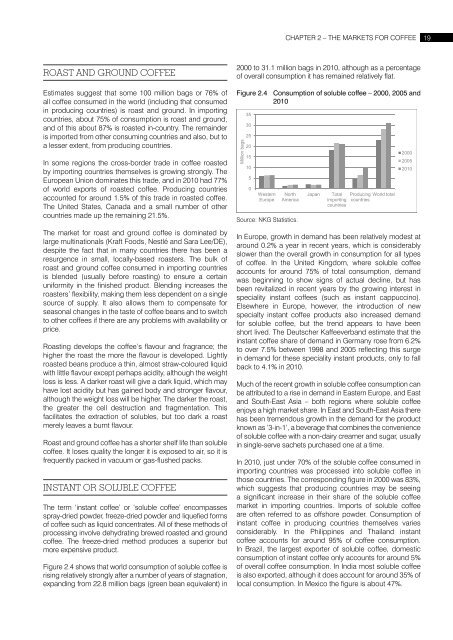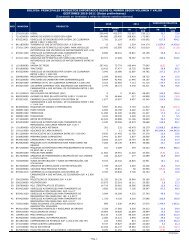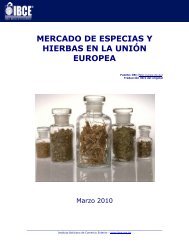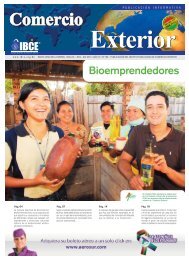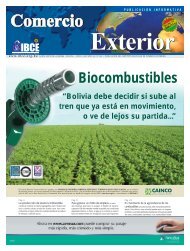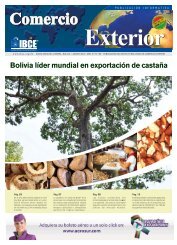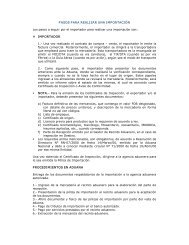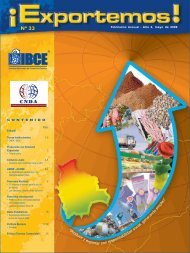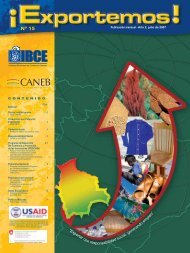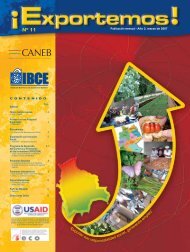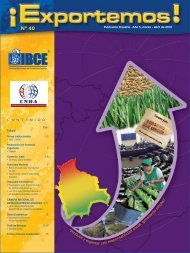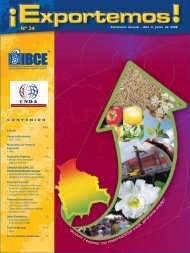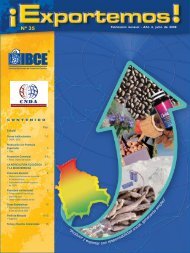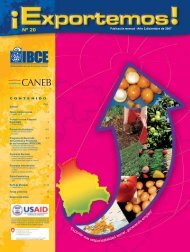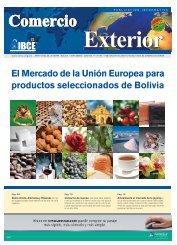The Coffee Exporter's Guide - International Trade Centre
The Coffee Exporter's Guide - International Trade Centre
The Coffee Exporter's Guide - International Trade Centre
- TAGS
- www.ibce.org.bo
Create successful ePaper yourself
Turn your PDF publications into a flip-book with our unique Google optimized e-Paper software.
ROAST AND GROUND COFFEE<br />
Estimates suggest that some 100 million bags or 76% of<br />
all coffee consumed in the world (including that consumed<br />
in producing countries) is roast and ground. In importing<br />
countries, about 75% of consumption is roast and ground,<br />
and of this about 87% is roasted in-country. <strong>The</strong> remainder<br />
is imported from other consuming countries and also, but to<br />
a lesser extent, from producing countries.<br />
In some regions the cross-border trade in coffee roasted<br />
by importing countries themselves is growing strongly. <strong>The</strong><br />
European Union dominates this trade, and in 2010 had 77%<br />
of world exports of roasted coffee. Producing countries<br />
accounted for around 1.5% of this trade in roasted coffee.<br />
<strong>The</strong> United States, Canada and a small number of other<br />
countries made up the remaining 21.5%.<br />
<strong>The</strong> market for roast and ground coffee is dominated by<br />
large multinationals (Kraft Foods, Nestlé and Sara Lee/DE),<br />
despite the fact that in many countries there has been a<br />
resurgence in small, locally-based roasters. <strong>The</strong> bulk of<br />
roast and ground coffee consumed in importing countries<br />
is blended (usually before roasting) to ensure a certain<br />
uniformity in the fi nished product. Blending increases the<br />
roasters’ fl exibility, making them less dependent on a single<br />
source of supply. It also allows them to compensate for<br />
seasonal changes in the taste of coffee beans and to switch<br />
to other coffees if there are any problems with availability or<br />
price.<br />
Roasting develops the coffee’s fl avour and fragrance; the<br />
higher the roast the more the fl avour is developed. Lightly<br />
roasted beans produce a thin, almost straw-coloured liquid<br />
with little fl avour except perhaps acidity, although the weight<br />
loss is less. A darker roast will give a dark liquid, which may<br />
have lost acidity but has gained body and stronger fl avour,<br />
although the weight loss will be higher. <strong>The</strong> darker the roast,<br />
the greater the cell destruction and fragmentation. This<br />
facilitates the extraction of solubles, but too dark a roast<br />
merely leaves a burnt fl avour.<br />
Roast and ground coffee has a shorter shelf life than soluble<br />
coffee. It loses quality the longer it is exposed to air, so it is<br />
frequently packed in vacuum or gas-fl ushed packs.<br />
INSTANT OR SOLUBLE COFFEE<br />
<strong>The</strong> term ‘instant coffee’ or ‘soluble coffee’ encompasses<br />
spray-dried powder, freeze-dried powder and liquefi ed forms<br />
of coffee such as liquid concentrates. All of these methods of<br />
processing involve dehydrating brewed roasted and ground<br />
coffee. <strong>The</strong> freeze-dried method produces a superior but<br />
more expensive product.<br />
Figure 2.4 shows that world consumption of soluble coffee is<br />
rising relatively strongly after a number of years of stagnation,<br />
expanding from 22.8 million bags (green bean equivalent) in<br />
CHAPTER 2 – THE MARKETS FOR COFFEE 19<br />
2000 to 31.1 million bags in 2010, although as a percentage<br />
of overall consumption it has remained relatively fl at.<br />
Figure 2.4 Consumption of soluble coffee – 2000, 2005 and<br />
2010<br />
Million bags<br />
35<br />
30<br />
25<br />
20<br />
15<br />
10<br />
5<br />
0<br />
Western<br />
Europe<br />
North<br />
America<br />
Source: NKG Statistics.<br />
Japan Total<br />
importing<br />
countries<br />
Producing World total<br />
countries<br />
2000<br />
2005<br />
2010<br />
In Europe, growth in demand has been relatively modest at<br />
around 0.2% a year in recent years, which is considerably<br />
slower than the overall growth in consumption for all types<br />
of coffee. In the United Kingdom, where soluble coffee<br />
accounts for around 75% of total consumption, demand<br />
was beginning to show signs of actual decline, but has<br />
been revitalized in recent years by the growing interest in<br />
speciality instant coffees (such as instant cappuccino).<br />
Elsewhere in Europe, however, the introduction of new<br />
specialty instant coffee products also increased demand<br />
for soluble coffee, but the trend appears to have been<br />
short lived. <strong>The</strong> Deutscher Kaffeeverband estimate that the<br />
instant coffee share of demand in Germany rose from 6.2%<br />
to over 7.5% between 1998 and 2005 refl ecting this surge<br />
in demand for these speciality instant products, only to fall<br />
back to 4.1% in 2010.<br />
Much of the recent growth in soluble coffee consumption can<br />
be attributed to a rise in demand in Eastern Europe, and East<br />
and South-East Asia – both regions where soluble coffee<br />
enjoys a high market share. In East and South-East Asia there<br />
has been tremendous growth in the demand for the product<br />
known as ‘3-in-1’, a beverage that combines the convenience<br />
of soluble coffee with a non-dairy creamer and sugar, usually<br />
in single-serve sachets purchased one at a time.<br />
In 2010, just under 70% of the soluble coffee consumed in<br />
importing countries was processed into soluble coffee in<br />
those countries. <strong>The</strong> corresponding fi gure in 2000 was 83%,<br />
which suggests that producing countries may be seeing<br />
a signifi cant increase in their share of the soluble coffee<br />
market in importing countries. Imports of soluble coffee<br />
are often referred to as offshore powder. Consumption of<br />
instant coffee in producing countries themselves varies<br />
considerably. In the Philippines and Thailand instant<br />
coffee accounts for around 95% of coffee consumption.<br />
In Brazil, the largest exporter of soluble coffee, domestic<br />
consumption of instant coffee only accounts for around 5%<br />
of overall coffee consumption. In India most soluble coffee<br />
is also exported, although it does account for around 35% of<br />
local consumption. In Mexico the fi gure is about 47%.


